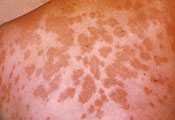Symptoms of Valley Fever (Coccidioidomycosis)

Cough and fever are common symptoms of Valley fever

Rash (erythema nodosum) due to Valley fever
Many people who are exposed to the fungus Coccidioides never have symptoms.1 Other people may have flu-like symptoms that go usually away on their own after weeks to months. If your symptoms last for more than a week, contact your healthcare provider.
Symptoms of Valley fever include:
- Fatigue (tiredness)
- Cough
- Fever
- Shortness of breath
- Headache
- Night sweats
- Muscle aches or joint pain
- Rash on upper body or legs
In extremely rare cases, the fungal spores can enter the skin through a cut, wound, or splinter and cause a skin infection.2
How soon do the symptoms appear?
Symptoms of Valley fever may appear between 1 and 3 weeks after a person breathes in the fungal spores.
How long do the symptoms last?
The symptoms of Valley fever usually last for a few weeks to a few months.3, 4 However, some patients have symptoms that last longer than this, especially if the infection becomes severe.
Severe Valley fever
Approximately 5 to 10% of people who get Valley fever will develop serious or long-term problems in their lungs.4 In an even smaller percent of people (about 1%), the infection spreads from the lungs to other parts of the body, such as the central nervous system (brain and spinal cord), skin, or bones and joints.4–6
References
- Smith CE, Whiting EG, et al. The use of coccidioidin. American review of tuberculosis 1948;57:330-60.
- Chang A, Tung RC, McGillis TS, Bergfeld WF, Taylor JS. Primary cutaneous coccidioidomycosis. J Am Acad Dermatol. 2003 Nov;49(5):944-9.
- Tsang CA, Anderson SM, Imholte SB, et al. Enhanced surveillance of coccidioidomycosis, Arizona, USA, 2007-2008. Emerg Infect Dis 2010;16:1738-44.
- Thompson GR, 3rd. Pulmonary coccidioidomycosis. Seminars in respiratory and critical care medicine 2011;32:754-63.
- Crum NF, Lederman ER, Stafford CM, Parrish JS, Wallace MR. Coccidioidomycosis: a descriptive survey of a reemerging disease. Clinical characteristics and current controversies. Medicine 2004;83:149-75.
- Galgiani JN, Ampel NM, Blair JE, et al. Coccidioidomycosis. Clin Infect Dis 2005;41:1217-23.
- Page last reviewed: January 25, 2017
- Page last updated: January 25, 2017
- Content source:


 ShareCompartir
ShareCompartir